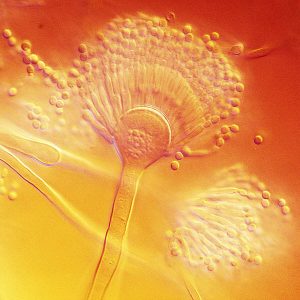Pathogenic fungi make people and other organisms sick and can kill them. For humans, about 300 pathogenic species of fungi are known. Some of them are Candida, Aspergillus, Cryptococcus, Histoplasma, Pneumocystis and Stachybotrys. One example of Cryptococcus is Cryptococcus neoformans which causes severe meningitis in people who are infected with HIV or have AIDS.
The skin, gastrointestinal tract, respiratory tract and genital-urinary tract are areas of the body that often become infected with pathogenic fungi. People with higher levels of monocytes/macrophages, invariant natural killer (iNK) T-cells and dendritic cells have a better chance of controlling a fungus infection and preventing it from spreading throughout the body.

The image above shows Aspergillus terreus. This pathogenic fungus causes infections of the ears, skin, nails and lungs of people with compromised immune systems.
References
- Pathogenic Fungus. (n.d.). In Wikipedia. Retrieved January 9, 2018 from https://en.wikipedia.org/wiki/Pathogenic_fungus
